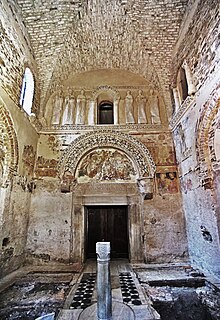Duchy of Friuli
This article needs additional citations for verification. (July 2016) |
Duchy of Friuli | |||||||||
|---|---|---|---|---|---|---|---|---|---|
| 568–828 | |||||||||
 The Duchy of Friuli in the northeast within Lombard Italy | |||||||||
| Status | |||||||||
| Capital | Cividale | ||||||||
| Common languages | |||||||||
| Government | Duke of Friuli | | |||||||
• 568-~584 or 568/c.584–590 | Grasulf I or Gisulf I (first) | ||||||||
• 774-776 | Hrodgaud | ||||||||
• 819-828 | Baldric (last) | ||||||||
| Historical era | conquered | 773-774 | |||||||
• Divided into smaller counties | 828 | ||||||||
• Reestablished as the March of Friuli | 846 | ||||||||
| |||||||||
| Today part of | Friuli-Venezia Giulia | ||||||||
The Duchy of Friuli was a

Along with the dukes of
History

Origins
The Venetian territory around Forum Iulii, still devastated by the Gothic War, was the first in former Roman Italy to be conquered by the Lombards under their king Alboin in 568. Before continuing on to penetrate Italy further southwards, Alboin left a large garrison at Cividale and placed the government of the district under his nephew and Marepaphias (shield-bearer), Gisulf as a dux, who was allowed to choose the faras or noble families with which he wished to settle the land.[2]
The original duchy was bound by the
Grisulf, a capable ruler according to the Historia Langobardorum chronicles by Paul the Deacon, suppressed the Roman population in Friuli. He gained even greater influence during the Lombard interregnum upon the death of King Cleph in 574. Little is known of Gisulf's first successor, Grasulf I
Seventh century

Around 610, Avar forces invaded Friuli pillaging the Lombard settlements. While King Agilulf did not take any action, Duke Gisulf II was killed in battle when the invaders occupied his residence at Cividale. Paul the Deacon recounts the event in epic tones.[3] Paul, who was originally from the duchy of Friuli also recounts in detail the betrayal of Romilda, Gisulf's wife, who handed the city of Cividale over to the Avars. They sacked the duchy and then withdrew to Pannonia. Gisulf II's sons, Tasso and Kakko had narrowly managed to escape the battle in which their father lost his life and assumed control of Friuli. They undertook a campaign against the Slavs and temporarily extended the eastern borders of the duchy up to Matrei in present East Tyrol. The Slavs continued to pay tribute to Friuli until the reign of Ratchis. The brothers also undertook campaigns against the Byzantine forces in Italy. In 615, Concordia was captured, and around 625 the brothers were killed in an ambush at the Byzantine city of Oderzo by the patrician Gregorius.[4]
The Ducal throne was then assumed by
Wechtar, originally from
Eighth century
On Ado's death, at the beginning of the 8th century, the duchy passed to

Pemmo was esteemed by Paul the Deacon (who calls him "an intelligent man who was useful to the country"
The new duke led an expedition into the Slavic territory (Carniola) and pillaged it as a proof of his valour. Rachis and his warriors also distinguished themselves in the defence of Liutprand when he was attacked and betrayed on the march to Fossombrone by the rebellious Duchy of Spoleto. As a result of the prestige that he had gained from these ventures, Rachis became king of the Lombards in 744, deposing Liutprand's successor Hildeprand after a few months of rule. Rachis assigned the duchy to his brother Aistulf, who only held it for a few years, since in 749 he succeeded Rachis (who had been deposed by his dukes) as king of Italy.
Information about the situation in the Duchy during the final years of the Lombard kingdom is scarce. It was ruled by the co-regents, Anselm and Peter (749-756) and the final duke that we know of was Hrodgaurd (774-776). It is likely that in these years, when the Lombard kingdom was ruled by sovereigns of Friulian origin and the central power was particularly strong, that the autonomy of the duchy was very limited. An indirect piece of evidence for this is the fact that Istria, which was conquered by Aistulf after he became king, was not annexed to the Duchy, but remained under direct royal control.
Friuli after the fall of the Lombard kingdom
After the
In the early modern period, the Habsburg-ruled
Dukes
- 568–c.584 Grasulf I
- 568/c.584–590 Gisulf I
- 590–610 Gisulf II
- 610–617 Tasso
- 610–617 Kakko
- 617–651 Grasulf II
- 651–663 Ago
- 663–666 Lupus
- 666 Arnefrid
- 666–678 Wechtar
- 678–??? Landar
- ???–694 Rodoald
- 694 Ansfrid
- 694–705 Ado
- 705 Ferdulf
- 705–706 Corvulus
- 706–739 Pemmo
- 739–744 Ratchis, also king of the Lombards
- 744–749 Aistulf, also king of the Lombards
- 749–751 Anselm (d.806)
- 751–774 Peter
- 774–776 Hrodgaud
Notes
Sources
- Paul the Deacon. Historia Langobardorum. Translated by William Dudley Foulke. University of Pennsylvania: 1907.
- Hodgkin, Thomas. Italy and her Invaders. Clarendon Press: 1895.
